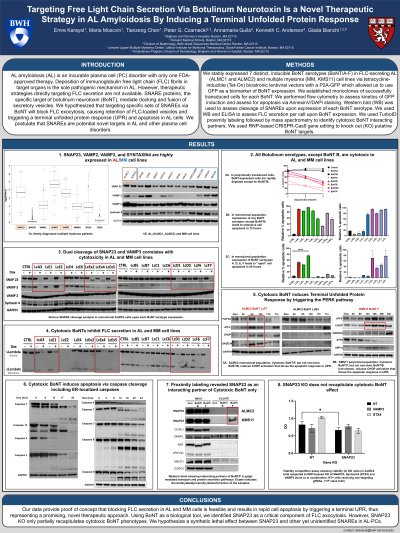Other plasma cell disorders
Poster Session 3
P-433: Targeting Free Light Chain Secretion Via Botulinum Neurotoxin Is a Novel Therapeutic Strategy in AL Amyloidosis By Inducing a Terminal Unfolded Protein Response
Friday, September 29, 2023
1:15 PM - 2:15 PM EEST


Emre KARAYOL, MD (he/him/his)
Research Fellow
Brigham and Women's Hospital
Boston, Massachusetts, United States
Introduction: AL amyloidosis (AL) is an incurable plasma cell (PC) disorder with only one FDA-approved therapy. Deposition of immunoglobulin free light chain (FLC) fibrils in target organs is the sole pathogenic mechanism in AL. However, therapeutic strategies directly targeting FLC secretion are not available. SNARE proteins, the specific target of botulinum neurotoxin (BoNT), mediate docking and fusion of secretory vesicles. We hypothesized that targeting specific sets of SNAREs via BoNT will block FLC exocytosis, causing retention of FLC-loaded vesicles and triggering a terminal unfolded protein response (UPR) and apoptosis in AL cells. We postulate that SNAREs are potential novel targets in AL and other plasma cell disorders.
Methods: We stably expressed 7 distinct, inducible BoNT serotypes (BoNT/A-F) in FLC-secreting AL (ALMC1 and ALMC2) and multiple myeloma (MM, KMS11) cell lines via tetracycline-inducible (Tet-On) bicistronic lentiviral vectors with a P2A-GFP which allowed us to use GFP as a biomarker of BoNT expression. We established monoclones of successfully transduced cells for each BoNT. We performed flow cytometry to assess kinetics of GFP induction and assess for apoptosis via AnnexinV/DAPI staining. Western blot (WB) was used to assess cleavage of SNAREs upon expression of each BoNT serotype. We used WB and ELISA to assess FLC secretion per cell upon BoNT expression. We used TurboID proximity labeling followed by mass spectrometry to identify cytotoxic BoNT interacting partners. We used RNP-based CRISPR-Cas9 gene editing to knock out (KO) putative BoNT targets.
Results: By querying the IFM170 gene expression database of newly diagnosed MM patients, we identified VAMP2, VAMP3, and SNAP23 as the top expressed SNAREs. Their high expression was retained in a large AL and MM cell line panel. Expression of all BoNT serotypes, except BoNT B, led to rapid apoptosis of AL and MM cells, with BoNT F standing out for extent and rapidity of cytotoxicity. Dual cleavage of SNAP23 and VAMP3 correlated with cytotoxicity of BoNT in AL and MM cell lines. Mechanistically, we showed that cytotoxic BoNTs, but not non-toxic BoNT B, led to decreased FLC secretion and increased FLC retention and triggered the PERK pathway of the UPR with increased expression of CHOP and GADD34 preceding onset of apoptosis. We identified SNAP23 as an interacting partner of cytotoxic BoNT F, but not non-toxic BoNT B. KO experiment showed SNAP23 KO to be partially toxic for AL and MM cell lines but did not recapitulate the effects of cytotoxic BoNTs entirely, suggesting “synthetic lethality” with concurrent targeting of yet unidentified SNAREs.
Conclusions: Our data provide proof of concept that blocking FLC secretion in AL and MM cells is feasible and results in rapid cell apoptosis by triggering a terminal UPR, thus representing a promising, novel therapeutic approach. Using BoNT as a biological tool, we identified SNAP23 as a critical component of FLC exocytosis, paving the way for the design of novel therapeutics.
Methods: We stably expressed 7 distinct, inducible BoNT serotypes (BoNT/A-F) in FLC-secreting AL (ALMC1 and ALMC2) and multiple myeloma (MM, KMS11) cell lines via tetracycline-inducible (Tet-On) bicistronic lentiviral vectors with a P2A-GFP which allowed us to use GFP as a biomarker of BoNT expression. We established monoclones of successfully transduced cells for each BoNT. We performed flow cytometry to assess kinetics of GFP induction and assess for apoptosis via AnnexinV/DAPI staining. Western blot (WB) was used to assess cleavage of SNAREs upon expression of each BoNT serotype. We used WB and ELISA to assess FLC secretion per cell upon BoNT expression. We used TurboID proximity labeling followed by mass spectrometry to identify cytotoxic BoNT interacting partners. We used RNP-based CRISPR-Cas9 gene editing to knock out (KO) putative BoNT targets.
Results: By querying the IFM170 gene expression database of newly diagnosed MM patients, we identified VAMP2, VAMP3, and SNAP23 as the top expressed SNAREs. Their high expression was retained in a large AL and MM cell line panel. Expression of all BoNT serotypes, except BoNT B, led to rapid apoptosis of AL and MM cells, with BoNT F standing out for extent and rapidity of cytotoxicity. Dual cleavage of SNAP23 and VAMP3 correlated with cytotoxicity of BoNT in AL and MM cell lines. Mechanistically, we showed that cytotoxic BoNTs, but not non-toxic BoNT B, led to decreased FLC secretion and increased FLC retention and triggered the PERK pathway of the UPR with increased expression of CHOP and GADD34 preceding onset of apoptosis. We identified SNAP23 as an interacting partner of cytotoxic BoNT F, but not non-toxic BoNT B. KO experiment showed SNAP23 KO to be partially toxic for AL and MM cell lines but did not recapitulate the effects of cytotoxic BoNTs entirely, suggesting “synthetic lethality” with concurrent targeting of yet unidentified SNAREs.
Conclusions: Our data provide proof of concept that blocking FLC secretion in AL and MM cells is feasible and results in rapid cell apoptosis by triggering a terminal UPR, thus representing a promising, novel therapeutic approach. Using BoNT as a biological tool, we identified SNAP23 as a critical component of FLC exocytosis, paving the way for the design of novel therapeutics.
